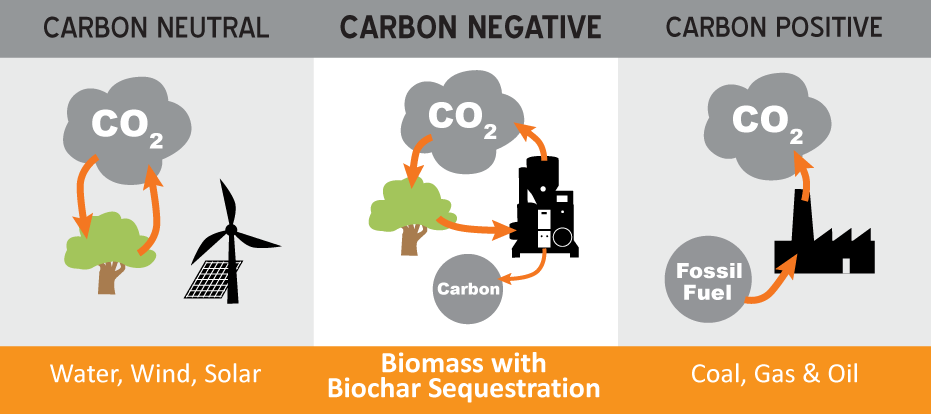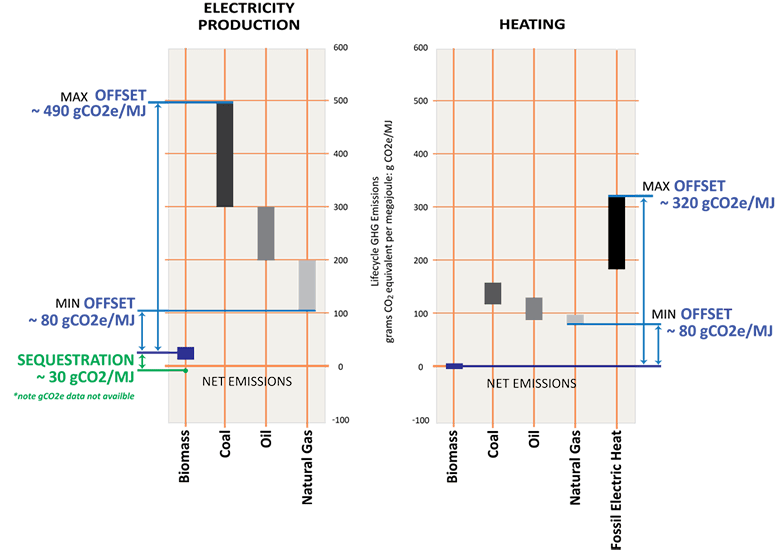APL has expanded its mission of developing and promoting energy-based solutions to the climate problem into the Carbon Drawdown side of the equation. We have created the Local Carbon Network where we are not only facilitating local, personal-scale carbon sequestration, but are also curating information, data, and articles about biochar, regenerative agriculture, and all things carbon and soil on our Medium Channel.
Biomass-based solutions to climate change are of unique interest in that the hardest problem—the capture and storage of atmospheric CO2—is already solved and globally installed at scale in the form of plant photosynthesis. We don’t have to start from scratch, as with expensive direct capture of atmospheric CO2; we only have to process the biomass in some form that prevents the captured CO2 from returning to atmosphere. Our approach is included as a promising negative emission technology (NET) in an IPCC special report.
When fueled by sustainably-sourced biomass, power generation with a Power Pallet is a carbon-neutral process. However, the Power Pallet can also stabilize a portion of the biomass carbon, which would have been released in natural decomposition, into a carbon-rich waste byproduct – biochar. When mixed with soil, the carbon in the biochar can be sequestered from the atmosphere for centuries or more, making the Power Pallet one of the only carbon-negative technologies currently ready for global deployment.
Biomass-based energy generation has long been considered carbon neutral to an approximation, as the carbon released during combustion was recently removed from the atmosphere to make the biomass. No new carbon is added to the terrestrial and atmospheric carbon cycle, as no ancient fossil carbon is dug up and reintroduced to the cycle.
The Biomass Gasification + Biochar solution uses the charcoal byproduct produced by gasification during power generation as the carbon store that can be collected and sequestered. Sequestration is much easier than flue stack CO2 gas capture and storage, as char is a solid and easy to handle. Biochar is equally important as a soil amendment, with surprisingly powerful benefits to plant productivity, soil biological activity, water retention, pest management and mineral uptake in plants. And as it is known to be stable in soil for 100s to 1000s of year timeframes, it is a low tech and cheap method for carbon storage, already with a scaled infrastructure via global agriculture. The combination is an unique “win, win win” across energy, agriculture and climate management.
Note that throughout the data presented here, sequestration values will be shown in Green, and fossil fuel offset values in Blue.
Potential of APL Technology:
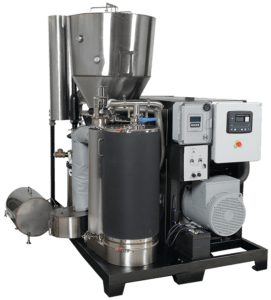
Power Pallet
Here are the specifics of the accounting for a PP30 Power Pallet running for 3500 hours per year at 25 kW electrical output, and consuming 1.1 kg/kWh of fuel:
- Output 88 megawatt hours per year (MWh/yr) of electricity (secondary energy)
- Consume 96 metric tons per year (tonnes/yr) of biomass
- Sequester 5 tonnes carbon/yr or 15 tonnes CO2/yr (assuming 5% by input mass carbon sequestration)
- Offset from 25-155 tonnes CO2e/yr* compared to use of fossil fuel for electrical generation.**
- Offset rises to 47-352 tonnes CO2e/yr when including combined heat and power (CHP) option compared to fossil fuel for combined electrical and heat generation (assuming 68% total system efficiency)
Viewed in another way:
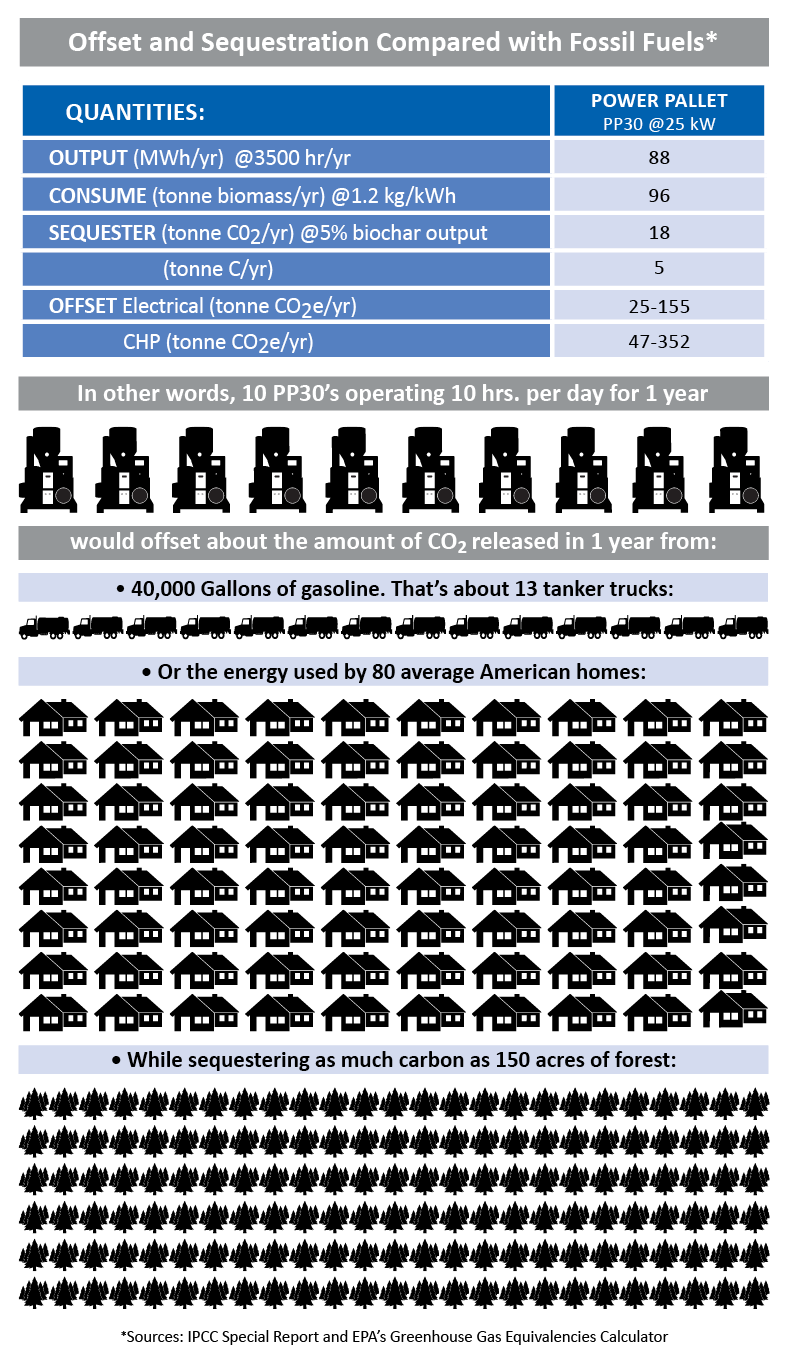
Notes
CHP represents an advantage to biomass power over other renewables such as wind and solar PV which are not capable of additional heat output.
**Note: Fossil-fuel values used for this comparison were based on the IPCC life cycle GHG emissions numbers.
*The unit: CO2e combines CO2 with the impact of other Green House Gas (GHG) emissions. Every greenhouse gas has its own global warming potential (GWP), which is an assessment of how much heat the particular GHG can trap within the atmosphere and how much of an environmental impact it is expected to have. For carbon accounting purposes, the EPA assigns a variable based on the IPCC’s AR4 report to account for what the GWP of each GHG gas, such as methane (CH4, for instance, has a 20 year GWP of 86, meaning that every unit of CH4 the same impact as 86 units of CO2) would be as an equivalent quantity of CO2.
Carbon Emission Factor
These charts show the emission intensity of various energy production systems. The range of factors describe the potential intensity for a variety of specific analyses of lifecycle emissions for various fuel types. The left block shows the range of offsets and sequestration for electrical energy generation. You can see that biomass electricity production generates from 5x times less emissions compared with fossil natural gas, to 50x times less compared with coal electricity production.
The right hand block shows the offsets from heating. Because a CHP system is only scavenging waste heat it can offset emissions by replacing direct fossil fuel or electric heating usage while requiring no additional fuel consumption.
These figures do not include potential land-use change impacts, however the use of ample waste or other sustainably sourced biomass should have little or no land-use impact.
Values are based on and graphic derived from the IPCC Special Report on Renewable Energy Sources and Climate Change Mitigation and assume a 5% input mass sequestration for Power Pallet operation.
Life Cycle Analysis
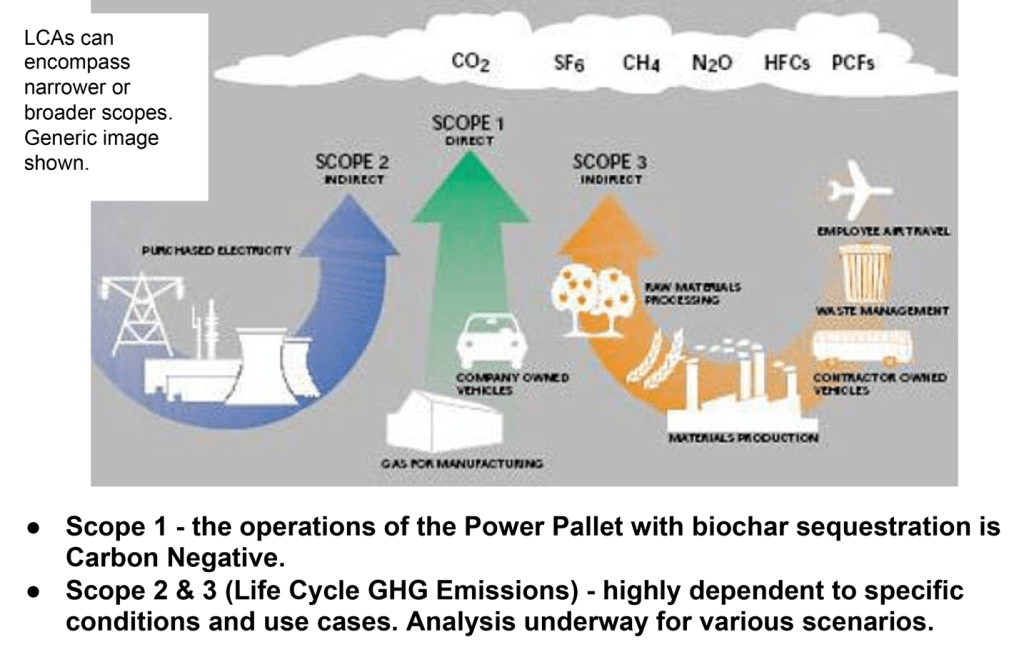
The Potential of APL Technology at 1 GW Capacity
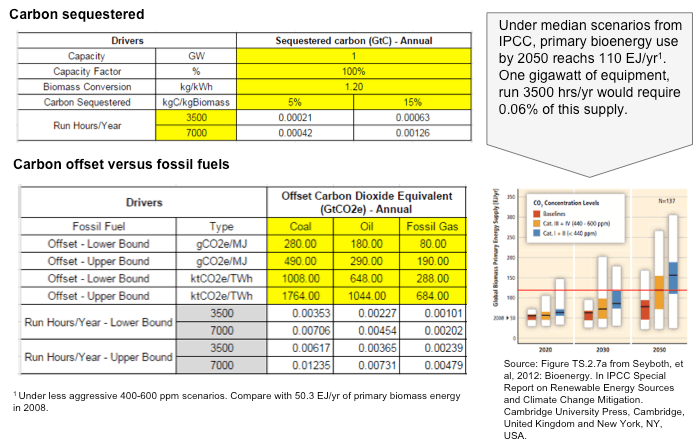
The following tables are designed to calculate the various carbon offsets and sequestration in varying use-case specifics. The variables of most of the drivers here are set to realistic values for actual Power Pallet operation. While we have not yet deployed the gigawatt of base units imagined here, we are trying our damnedest. The release of our 150 kW Powertainer unit in the near future will help accelerate us to, and soon hopefully beyond, this 1 GW installed base.
For some more relatable numbers, and to provide a sense of scale and context, this 1 gigawatt of APL technology would roughly offset, in one year, the CO2 equivalent from:
1,000,000,000 pounds of coal burned, that’s over 5,000 rail cars or
2,500,000 barrels of oil
115,000 gallons of gasoline consumed, almost 15,000 tanker trucks worth, enough to fuel
200,000 passenger cars or enough energy to power
100,000 American homes.
This offset would be the equivalent amount of CO2 sequestered by:
25,000,000 tree seedlings grown for 10 years or
1,000,000 acres of forest.
We got these figures are from a handy EPA calculator. We took the lowest bound offset case of 0.00101 GtCO2e (3500 hrs/yr fossil gas) from the table above, converted it to metric tonnes (t) by multiplying by 10^9 (Giga) to get: 1,010,000 metric tonnes/year, and then plugged that number for this projected 1 GW capacity into that online calculator.

